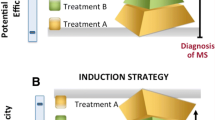Abstract
Most of the Consensus Groups in Europe and America support an early decision-making therapeutic approach in patients with a diagnosis of Multiple Sclerosis, either with IFNβ or GA which have been demonstrated to be a reasonable therapeutic strategy because of their benefit. The treat-early approach within disease management is based on the assumption, particularly during the early phase of the disease, on the reduction of both relapse rate and of the ongoing inflammatory processes. As soon as the MS diagnosis is certain or even in patients with a first episode suggestive of MS, with negative prognostic factors and a typical presentation, the induction therapy, which is more aggressive on the immune system, seems to have more relevant short-and long-lasting beneficial effects. However, if the disease course is suboptimally controlled, an escalating strategy, using either Mitoxantrone, Cyclophosphamide, various other immuno-active agents, or the combination of different drugs, is suggested. The current challenge in therapeutic strategy is to identify the most effective drug, or combination of drugs, during a specific phase of the disease of each single patient. Nevertheless, the decision to adopt a combination therapy in patients with a low response to monotherapy should not be delayed until severe irreversible disability is evident.
Similar content being viewed by others
References
Comi G (2008) Clinically isolated syndrome: the rationale for early treatment. Nat Clin Pract Neurol 4:234–235
Mancardi G, Saccardi R (2008) Autologous haematopoietic stem-cell transplantation in multiple sclerosis. Lancet Neurol 7:626–636
Zipoli V, Portaccio E, Hakiki B et al (2008) Intravenous mitoxantrone and cyclophosphamide as second-line therapy in multiple sclerosis: an open label comparative study of efficacy and safety. J Neurol Sci 266:25–30
Engelhardt B, Kappos L (2008) Natalizumab: targeting alpha4-integrins in multiple sclerosis. Neurodegener Dis 5:16–22
Talar-Williams C, Hijazi YM, Walther MM et al (1996) Cyclophosphamide-induced cystitis and bladder cancer in patients with Wegener granulomatosis. Ann Intern Med 124:477–484
Ghalie RG, Mauch E, Edan G et al (2002) A study of therapyrelated acute leukaemia after mitoxantrone therapy for multiple sclerosis. Mult Scler 8:441–445
Rodegher M, Esposito F, Radaelli M et al (2007) Clinical and neuroradiological response to mitoxantrone in a large group of multiple sclerosis patients. J Neurol 254[Suppl 3]:O217
Debouverie M, Taillandier L, Pittion-Vouyovitch S et al (2007) Clincial follow-up of 304 patients with multiple sclerosis three years after mitoxantrone treatment. Mult Scler 13:626–631
Cocco E, Marchi P, Sardu C et al (2007) Mitoxantrone treatment in patients with early relapsing-remitting multiple sclerosis. Mult Scler 13:975–980
Author information
Authors and Affiliations
Corresponding author
Rights and permissions
About this article
Cite this article
Comi, G. Induction vs. escalating therapy in Multiple Sclerosis: practical implications. Neurol Sci 29 (Suppl 2), 253–255 (2008). https://doi.org/10.1007/s10072-008-0954-x
Published:
Issue Date:
DOI: https://doi.org/10.1007/s10072-008-0954-x



